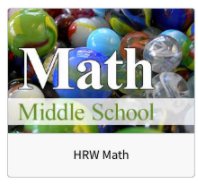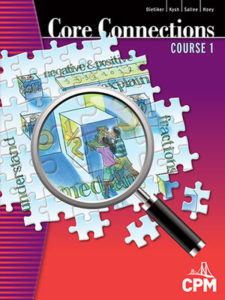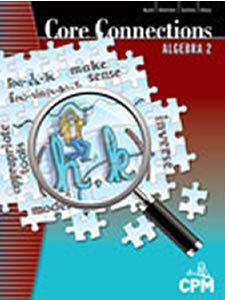Secondary Mathematics (Grades 6-12) Information for Families
The Lincoln Public Schools secondary math program is based on a set of specific standards and course objectives. The district math standards are the Nebraska State Math Standards and specific course objectives have been designed to ensure students have the opportunity to acquire the knowledge and skills outlined in the 2015 Nebraska College and Career Readiness Standards for Mathematics.
Middle School Math Course 1 (6th Grade)
This course includes work with integers, factors and multiples, operations with positive rational numbers, equivalent expressions, one step equations, an introduction to inequalities, relationships in geometry, coordinate plane geometry, measurement and data, rates, ratios and percents. Throughout the class, exploration and technology are utilized in problem solving. Parent/Student Resources
Middle School Math Course 1D (6th Grade)
This course includes work with factors and multiples, operations with positive rational numbers, operations with integers, equivalent expressions, two step equations, an introduction to inequalities, relationships in two variables, relationships in geometry, coordinate plane geometry, measurement and data, rates, ratios and percents. Throughout the class, exploration and technology are utilized in problem solving. Parent/Student Resources
Middle School Math Course 2 (7th Grade)
This course includes integer operations, rational number operations, percent relationships, expressions and equations, solving inequalities, statistics, probability, geometric figures, ratios and proportional relationships. Throughout the class, exploration and technology are utilized in problem solving. Student/Parent Resources
Middle School Math Course 2D (7th Grade)
This course includes Integer Operations, Rational Number Operations, Percent, Simplify Expressions and Solve Linear Equations, Solve Inequalities, Scientific Notation, Real Numbers, Probability, Geometry, Transformational Geometry, 3-D Geometry, and Angle Relationships. Throughout the class, exploration and technology is utilized in problem solving. Student/Parent Resources
Middle School Math Course 3 (8th Grade)
This course includes solving equations, solving inequalities, real numbers, angle relationships, Pythagorean Theorem, transformational geometry, volume, proportional relationships, and scatter plots. Throughout the class, exploration and technology are utilized in problem solving. Student/Parent Resources
Accelerated Math
Accelerated Math provides individualized and compacted instruction focused on essential concepts from the pre-Algebra curriculum . The purpose is to prepare students for success in first year Algebra.
Support Classes - Algebra/Geometry/Advanced Algebra
Support classes are taken in addition to a regular math course to provide additional instructional support. Students must be enrolled in the appropriate math course at the same time as the Support class. The grade for the Support class will take into consideration the student’s grade in their regular math course. In order to earn credit for the Support class, students must pass both the regular math course and the Support class.
Algebra/Algebra Block/Algebra D
Algebra is the first class in the traditional college preparatory sequence. The class explores the solutions of open sentences using the basic operations, linear sentences, lines and distance, slopes and distance, exponents and powers, polynomials, systems of equations, quadratic equations, functions, statistics, and informal geometry. Throughout the class, appropriate applications are explored and technology utilized in problem solving. Student/Parent Resources
Geometry/Geometry Block/Geometry D
Technology and cooperative investigations are the vehicles by which students discover angle relationships and properties of triangles, quadrilaterals, regular polygons, parallel lines and planes, perpendicular lines, ratio and proportion, similar polygons, special properties of right triangles, circles, solid figures, areas, and transformations. Applications of geometry are emphasized throughout the class. After students have developed a geometric knowledge base using inductive reasoning, they verify their discoveries using deductive reasoning. Student/Parent Resources
Elements of Advanced Algebra
This semester is a review of algebra, statistics, probability, and geometry concepts. Students will preview skills required for advanced algebra.
Advanced Algebra/Advanced Algebra D
In Advanced Algebra, the core topics are again explored through the use of higher-level applications. Practical applications become the basis for the further investigation of linear and quadratic equations and inequalities, absolute value, fractions, linear systems in two and three variables, graphs and exponents. In addition, the class includes the study of applications of relations, functions, irrational and complex numbers, quadratic systems, matrices, logarithms, binomial expansions, sequences, and series. Student/Parent Resources
Precalculus/Precalculus D
Precalculus is designed for those students who intend to continue their study of mathematics in the traditional calculus sequence. This includes students interested in mathematics, the sciences, and engineering. This class includes a thorough study of elementary trigonometric functions and their properties; the limits of functions and sequences; properties of algebraic, exponential and logarithmic functions; and polar coordinates.
AP Calculus
AP Calculus is a college-level class covering topics that are normally studied during the first semester of the three semester college calculus course. This course goes at a slower pace than the Differentiated Calculus course. Students who successfully complete this course may enroll in the second semester of the calculus sequence at the University of Nebraska-Lincoln, and may qualify for university credit (half of the credit students who successfully complete the differentiated calculus course may earn).
AP Calculus D
AP Calculus is a college-level class covering topics that are normally studied during the first two calculus classes in college. Topics include conics, limits, continuity, derivatives, applications of differentials, the definite integral, trigonometric and exponential functions, vectors, methods of integration, and applications of the integral. Students who successfully complete two semesters of calculus may enroll in the third class of the calculus sequence at the University of Nebraska, Lincoln, and may qualify for university credit.
AP Statistics
The purpose of AP Statistics is to introduce students to the major concepts and tools for collecting, analyzing and drawing conclusions from data. Students are exposed to four broad conceptual themes:1. Exploring Data: Describing patterns and departures from patterns. 2. Sampling and Experimentation: Planning and conducting a study. 3. Anticipating Patterns: Exploring random phenomena using probability and simulation. 4. Statistical Inference: Estimating population parameters and testing hypotheses. Students who successfully complete the course and exam may receive credit, advanced placement or both, for a one-semester introductory college statistics course.
Why do students have math homework?
Homework is an opportunity for students to do independent practice of the concepts they are learning in math class.
How often will students have math homework?
Students in grades 6-12 will have math homework to do almost every night.
How can families/guardians help with homework?
Decide on a consistent place and time for students to work on their homework – help build a habit.
Provide encouragement, but don’t take over. It is important that teachers see the student’s thinking (even mistakes) on the homework page. Seeing where students have confusion helps the teacher make decisions about instruction.
Graduation Requirement
The high school graduation requirement is 30 hours of mathematics, including coursework in algebra and geometry. The 30 hours of mathematics credit must come from courses beginning with Algebra/Algebra Block (special education students will graduate according to requirements outlined in their IEP). This does not mean that a student has to pass each semester of algebra and geometry to graduate, only that a student’s 30 hours of mathematics must include, at a minimum, 5 hours of algebra credit and 5 hours of geometry credit
Grading
- In all courses in grades 6-12, the grading template is 80% summative and 20% formative.
- Only chapter/Big Idea assessments, cumulative assessments, and finals count in the summative category.
- Quizzes and homework count in the formative category.
Assessment and Reteaching
Reteaching and relearning is a research-based instructional strategy to improve student learning. The National Mathematics Advisory Panel recommended the use of assessments for the purpose of modifying instruction based on student progress (NMAP, 2008). Research indicates that when the results of assessment are used to provide students additional instruction, practice, and reinforcement in the skills and/or concepts with which they struggle, that student achievement is improved (Baker, Gersten, & Lee, 2002). Therefore, reteaching and re-assessment is now a required district expectation in mathematics from Kindergarten through Differentiated Precalculus. In order to prepare students for possible coursework beyond high school, there is a steady decline in the amount of re-assessment that takes place as students progress through the curriculum as outlined below:
- Middle School Math Courses (grades 6-8): Retesting occurs on either individual unit retention quizzes or cumulative assessments. Retesting is used for grade replacement. Please see individual course information for specific retesting opportunities.
- Algebra: Retesting occurs on unit assessments with a portion of the assessment on previous content. The retention portion of the assessment is used for grade replacement and a new summative grade.
- Geometry: Retesting occurs on unit assessments with a portion of the assessment on previous content. The retention portion of the assessment is used for grade replacement and a new summative grade.
- Advanced Algebra: Retesting occurs on unit assessments with a portion of the assessment on previous content. The retention portion of the assessment is used for grade replacement and a new summative grade.
- Precalculus: Retesting occurs only on first and third quarter cumulative assessments.
- Calculus: No retesting.
Format of District Assessments
The NeSA-M emphasizes the application of mathematics. Specifically, many of the assessment items on the NeSA-M require students to draw on a variety of mathematical topics and apply these topics to novel problems that students may have never previously seen. This places an emphasis on student mathematical understanding, as opposed to rote procedural skill, so that students can make appropriate connections among mathematical topics and draw on their understanding to solve problems. Therefore, all secondary math objectives and assessments through precalculus are organized around connected “Big Ideas.” It is a district expectation that common unit assessments, cumulative assessments, and finals will be used to ensure consistency and that they will not be modified (beyond special education requirements) to adjust the cognitive demand.
Retention
Reteaching (not just additional practice) and relearning must take place prior to reassessment for the strategy to be effective at improving student learning. It is assumed that all teachers will provide all students an opportunity to continue to master topics they have not yet mastered through appropriate reteaching either inside or outside of the regular instructional time. Because reassessment is embedded within formal and required district assessments, all students will have access to reassessment opportunities regardless of their compliance with behavioral expectations, e.g. homework completion.
Final Exam
The final exam serves to assess student learning across a semester’s essential topics. The final exam will account for approximately 10% of a student’s grade.
District Common Assessments
District Common Assessments (DCAs) are a critical component of the district’s preparation for statewide assessment. The goal is to gauge retention and application of concepts and skills in order to identify intervention needs. Results are used to plan intentional review and reteaching of critical state math standards.
Middle School
- Course 1 (6th Grade)
- Course 1D (6th Grade)
- Course 2 (7th Grade)
- Course 2D (7th Grade)
- Course 3 (8th Grade)
- Algebra D (8th Grade)
High School
 |
Course 2, Course 2D, and Course 3.Parent Resources for Go Math |
 |
6th Grade Math (Course 1 and 1D)Parent Resources |
 |
Algebra / Algebra DParent Resources for Algebra |
 |
GeometryParent Resources for Geometry |
 |
Advanced AlgebraParent Resources for Advanced Algebra |
